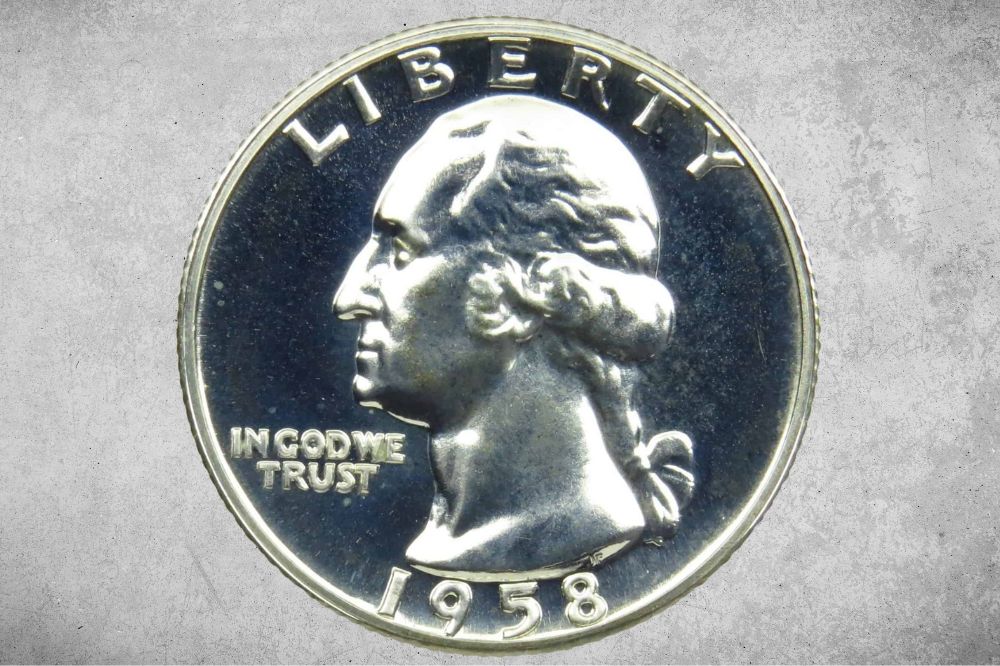The United States Mint produced the 1958 Washington Quarter currency as a part of the Washington Quarter series, which was first released in 1932 to mark the 200th anniversary of the birth of George Washington, the country’s first president.
As with all Washington quarters, the 1958 quarter’s observe side is adorned with a portrait of George Washington. On the coin’s reverse, an eagle is depicted holding an olive tree and arrows, and the words “Quarter Dollar,” “E Pluribus Unum,” and “United States of America” are written around the eagle.
If you are ready to learn more about this Washington quarter’s worth and variations, then this article is for you.
1958 Quarter Details
- Category: Washington Quarter
- Mint: Philadelphia, Denver
- Total Mintage: 85,360,552
- Obverse Designer: John Flanagan
- Reverse Designer: John Flanagan
- Composition: 90% silver and 10% copper
- Fineness: 0.9
- Weight: 6.25 grams
- ASW: 0.1808 oz
- Edge: Reeded
- Diameter: 24.3 mm
- Thickness: 1.75 mm
- Melt value: $4.09 as of March 19, 2023
Also Read: Top 16 Most Valuable Modern Quarters Worth Money
1958 Quarter Value Chart
| Mints | Good | Fine | Extremely Fine | Uncirculated |
| 1958 No Mint Mark Washington Quarter | $3.48 | $3.48 | $6.50 | $9.00 |
| 1958 “D” Washington Quarter | $3.48 | $3.48 | $6.50 | $9.00 |
| 1958 (proof) Washington Quarter | $8.00 | $8.00 | $11.00 | $17.00 |
1958 Quarter Values And Varieties Guides
1958 No Mint Mark Quarter Value
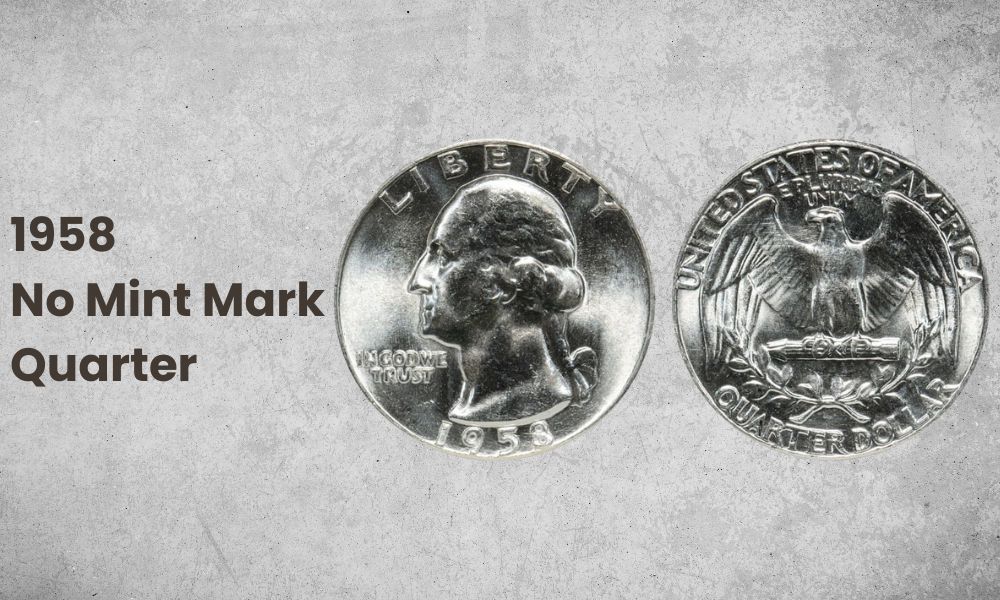
- Type: Washington Quarter
- Edge: Reeded
- Mint mark: No mint mark
- Place of Mint: Philadelphia
- Year of Mint: 1958
- Face Value: $0.25
- $ Price: $0.25 to $65
- Quantity Produced: 6,360,000
- Designer: John Flanagan
Millions of quarters were made by the United States Mint in 1958, but some of them were special because the usual “D” or “S” mint mark was missing from the back. These coins, also referred to as “1958 no mint mark quarters,” are highly prized by currency collectors.
The Philadelphia Mint created the 1958-P quarter piece, and 6,360,000 P Washington quarter coins were manufactured by the end of 1958, a much smaller quantity than the Denver Mint produced. Among the Washington quarters made between 1941 and 1964, it has the fourth-lowest mintage. Although 1958 no mint is not especially rare, collectors still value it for its uniqueness. The intriguing part is that, even though there aren’t many 1958-P quarters, you can still locate a lot of them in prize condition. Perhaps some people hoarded them hoping their worth would rise due to the low mintage.
Collectors need to be mindful that fake 1958 no-mint mark quarters are available. Having the coin graded by a respected third-party grading service, like PCGS or the Numismatic Guaranty Corporation (NGC), is the best way to guarantee authenticity. These services authenticate and grade coins according to their condition, ensuring that collectors receive the coins they purchased.
Although the 1958 no-mint quarter is not especially rare, collectors still value it for its uniqueness. The condition of the coin determines its worth, with uncirculated coins having the highest value. An uncirculated 1958 no-mint mark quarter may be worth more than $1,000, according to Professional Coin Grading Service (PCGS). Coins that have been in circulation for some time can also be precious, with some going for hundreds of dollars.
1958 “D” Mark Quarter Value
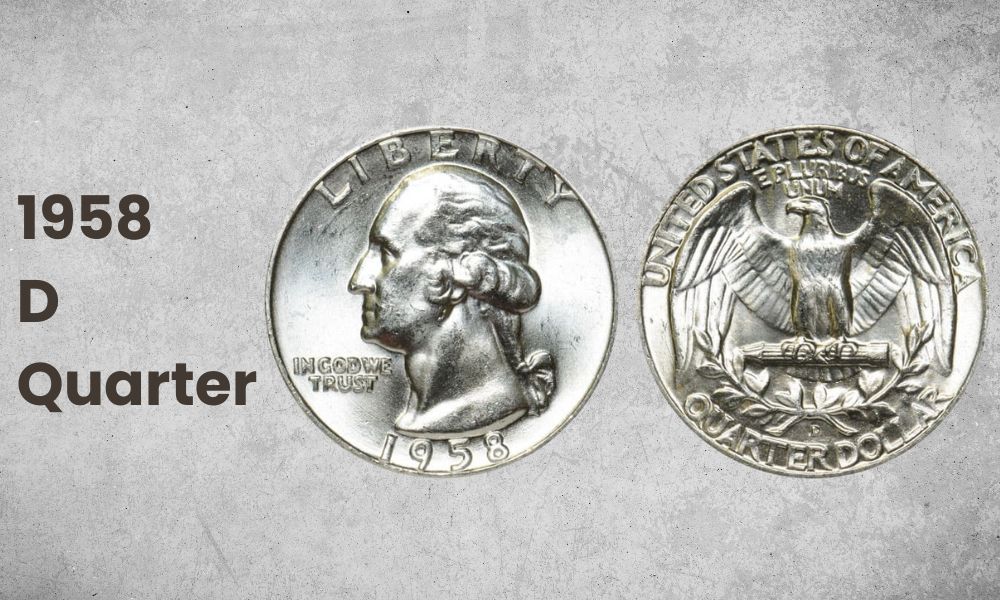
- Type: Washington Quarter
- Edge: Reeded
- Mint Mark: D
- Place of Minting: Denver
- Year of Minting: 1958
- Face Value: $0.25
- $ Price: $0.25 to $28
- Quantity Produced: 78,124,900
- Designer: John Flanagan
The coin’s “D” mint mark denotes that it was produced at the Denver Mint. In 1958, the Denver Mint produced over 78 million Washington Quarters, which was the highest mintage for any quarter up to that point in time. The 1958 D Washington Quarter is a common coin due to its high mintage and the fact that many of these coins were preserved by both collectors and the public. It is interesting to note that even though there were many D quarters produced in 1958, it is uncommon to find one in prize condition.
The 1958-D Washington Quarter has some value even though it is not rare. The coin’s condition and classification determine its worth. Coins with no wear, scratches, or other damages and in excellent shape are worth more than coins with these flaws. Depending on its quality and condition, a 1958-D Washington quarter may be worth a few dollars or several hundred dollars.
In conclusion, the 1958 D Quarter is a unique coin that’s sought after by collectors. The “D” mark and sharp strike are two distinguishing features that make it a treasured addition to any collection. Collectors should make sure they thoroughly inspect the condition of any 1958 D quarter they are contemplating buying to make sure they are getting a coin that is in the best possible condition.
1958 Proof Washington Quarter
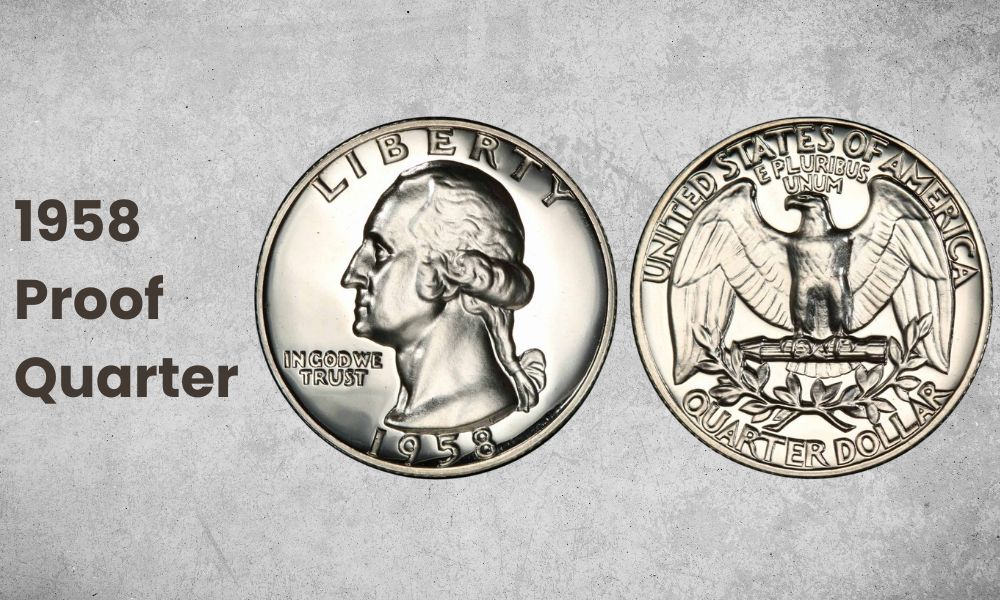
- Type: Washington Quarter
- Year of Minting: 1958
- Mint Mark: No Mint Mark
- Place of Mint: Philadelphia
- Quantity Produced: 876,652
- Face Value: $0.25
- $ Price Value: $8 to $26
- Edge: Reeded
- Designer: John Flanagan
The United States Mint created a special quarter known as the “Proof Quarter” in 1958. This currency was distinct from the common quarters in use at that time because it was made with collectors in mind rather than for general circulation. A higher degree of detail and a shiny, mirror-like surface were two distinctive features of the Proof Quarter. The 1958 Proof Quarter is now a prized currency among collectors and is capable of fetching a significant amount of money. Philadelphia-proof coins have the lowest mintage of all 1958 quarters that were officially released. Only about 875 thousand 1958-P quarter coins were made by the year’s end.
In addition, the 1958 proof quarter has several other distinctive features. For instance, the coin appears more three-dimensional because it has more texture than regular quarters. The coin has a brighter, lustrous look because it was struck with a better alloy than regular quarters.
The 1958 proof quarter is important not only for its rarity but also for the fact that it represents a change in US coinage. The US Mint was changing its coinage at this period from silver to an alloy of copper and nickel. The 1958 proof quarter is one of the final coins made with high silver content, making it a special example of coinage history.
Depending on its condition, rarity, and historical importance, the 1958-proof quarter’s value today varies. Because of its beauty, scarcity, and historical importance, this coin is sought after by investors and collectors alike, making it a valuable addition to any collection.
Also Read: Top 15 Most Valuable Quarters In Circulation
History of the 1958 Washington Quarter
In the history of the United States Mint, the 1958 quarter has a special position. The bicentennial of George Washington’s birth, which occurred in 1958, was commemorated by the issuance of this lovely and historic currency. The coin was part of the Washington Quarter series, a run of quarters that ran from 1932 to 1998. The Standing Liberty Quarter, which has been in circulation since 1916, was replaced with this series.
John Flanagan, a renowned artist, and designer was in charge of creating the 1958 quarter. On the coin’s obverse (front) side, Flanagan’s design includes a bust of George Washington alongside the inscriptions “United States of America” and “Quarter Dollar”. An eagle with wings spread wide, an olive branch in its beak, and arrows in its claws is depicted on the coin’s reverse (back). The eagle is encircled by the words “E Pluribus Unum”, which means “Out of Many, One”. The 1958 quarter was struck at the Philadelphia and Denver Mints. There is no mint mark on the coins produced at the Philadelphia Mint, but there is a “D” mint mark on coins produced at the Denver Mint.
Despite not being the first coin to depict George Washington, the 1958 quarter was significant in the history of the United States Mint. The coin’s design was so well-liked that it continued to be used for the Washington quarter up until 1998 when the statehood quarter program started.
Also Read: 10+ Rarest State Quarter Errors Lists (Worth Much Money!!!)
1958 Washington Quarter Grading
When grading a 1958 quarter, collectors should look at several factors. The general state of the coin should be taken into account first. A coin that is in mint shape will not show any signs of wear or tampering, and it will still have its original luster. Mint state coins are rated from MS-60 to MS-70, with MS-70 being the perfect coin with no imperfections.
Here’s how to grade your Washington quarter.
1958 Washington Quarter Errors
You’ll get more value for your coin if it has an error. However, this is not must as it depend on the severity of the error and the condition of the coin.
Some of the 1958 quarter errors include;
1. The 1958 Quarter Type B Rev Error
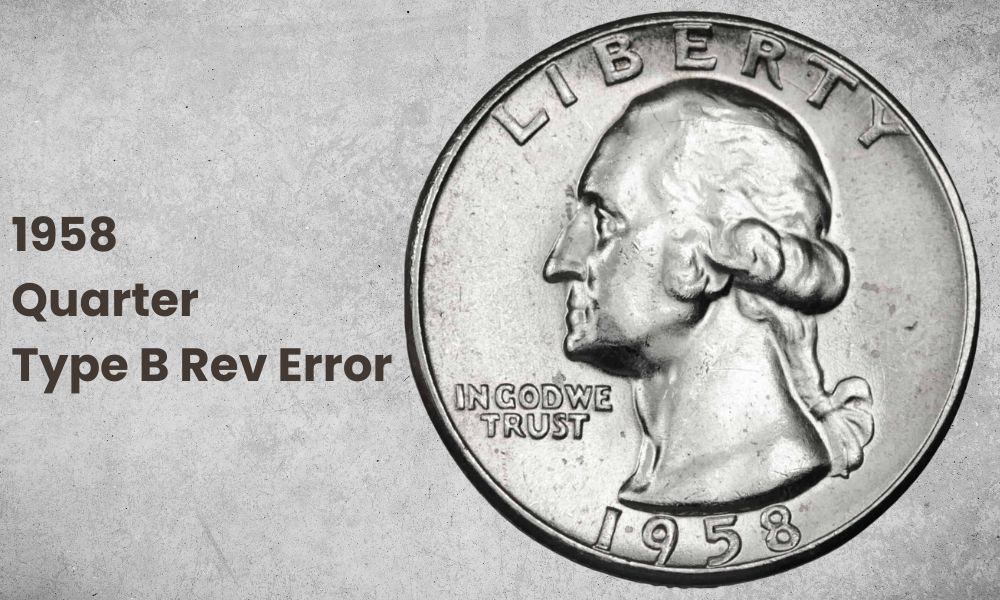
The Type B reverse error happens when the coin’s back design deviates just a little from the norm. The eagle’s claws in the standard form only have three talons that are visible; the fourth talon is concealed by the branch. The fourth talon is visible, making it more pronounced and conspicuous in the Type B reverse error.
Due to its scarcity, the Type B reserve error is highly prized by collectors. The flaw was isolated to Philadelphia Mint quarters, and it only affected a tiny percentage of the coins. A collector found the mistake in the 1960s, and ever since then, it has become sought-after.
2. The 1958 Quarter Double Die Error
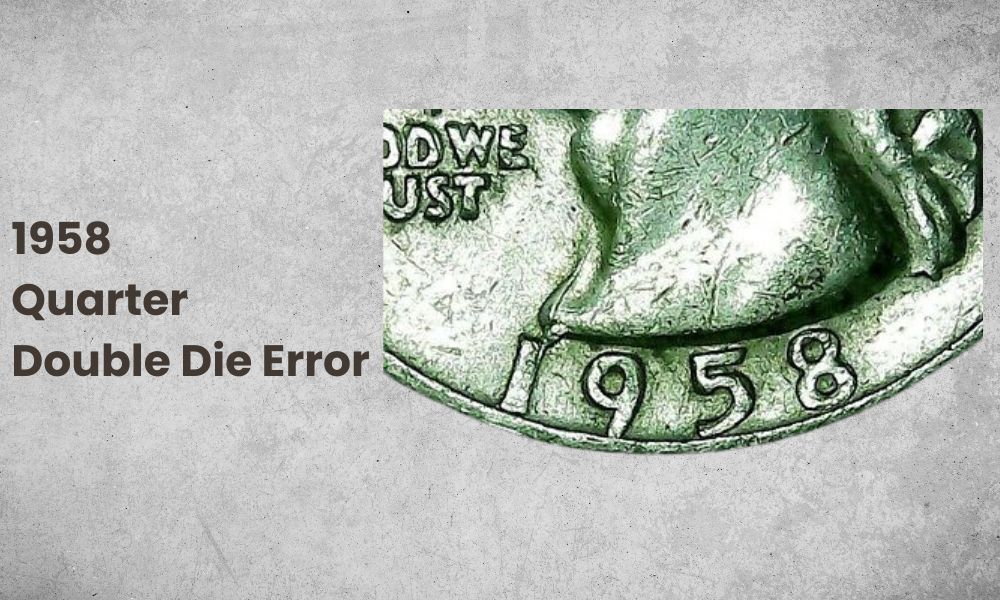
The Double Die error of the 1958 Quarter is one of the most well-known and valuable errors in the United States coinage history. Some of the quarters have a doubled picture as a result of a minting error. Since this mistake was not discovered right away, some of the quarters ended up in circulation and became highly prized by coin collectors.
The 1958 quarter’s doubled die mistake can be seen on the coin’s front, where George Washington’s profile appears to be duplicated. The phrase ” IN GOD WE TRUST,” the time, and the term “LIBERTY” where this is most obvious.
3. The 1958 Quarter Weak Strike Error
The 1958 quarter is a well-known example of an error coin with a weak strike on the reverse side. This mistake was made during the coin-making process when the coin press mis-hit the reverse die, leaving a faint imprint of the eagle’s talons and feathers.
The weak strike error is considered to be relatively uncommon and coins that show this error are highly sought after by collectors. The strike’s degree of weakness can vary. Some coins have only a minor loss of details, while others have almost no detail at all.
4. The 1958 Quarter Folded or Clipped Planchet Error
Folded planchet error happens when a planchet is unintentionally folded or creased before it is struck, leaving the coin with an irregular shape and possibly lacking some of its design elements. The degree of folding can vary, with some coins exhibiting only a light crease and others being severely misshaped.
A clipped planchet error, on the other hand, happens when a section is accidentally removed before the coin is struck, resulting in a coin with an irregular shape and lacking design elements on the clipped portion.
The folded and clipped planchet mistakes are both comparatively uncommon and in high demand among collectors. The coins become distinctive and stick out from the others as a result of these mistakes.
5. The 1958 Quarter Off-Center Strike
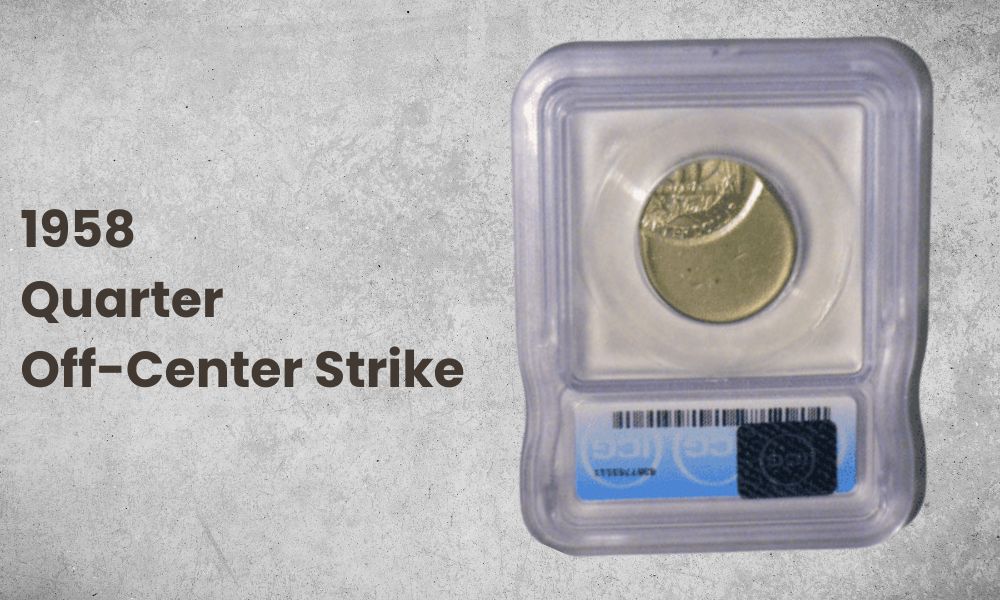
In 1958, a few US quarters were produced with an off-center error that left one side of the currency with a crescent-shaped blank space. The planchet was out of alignment before striking, which resulted in this production-related mistake. Due to their scarcity and distinctive design, 1958 off-center quarters command high prices from collectors and can be found at auction for large amounts.
Watch the video and check out other errors of the 1958 Washington quarter.
FAQs
1. Is Any Of The 1958 Quarter Rare?
It is rare to find a 1958 quarter with a Type B reverse error. Another uncommon 1958 quarter is the one that was struck on a cent planchet.
2. How High Can A 1958 Quarter Be Sold For?
A 1958 quarter in perfect uncirculated condition can sell for as much as $5,250.
Conclusion
The 1958 quarter is a well-liked collectible among coin enthusiasts and is valued for its historical importance and rarity in some circumstances. It continues to serve as a physical symbol of a bygone period in American history.
If you find one in your closet, take it to a professional so they can determine the real worth of your coin. You just might be sitting on several dollars, you’ll never know!
